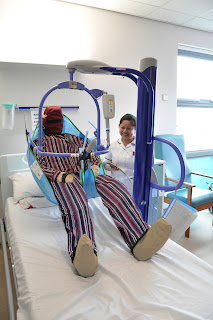Special Considerations for Bariatric Patients
Bariatric patients, individuals who are significantly overweight or obese, have specific needs related to their healthcare and daily living. These needs encompass various aspects of their physical, emotional, and social well-being. Here are some key considerations when caring for bariatric patients:
Specialized Equipment:
Bariatric patients often require specialized medical equipment, such as wider hospital beds, heavy-duty wheelchairs, commodes, and patient lifts, to ensure their comfort and safety.
Healthcare Staff Training:
Healthcare providers should be trained in proper bariatric patient care techniques, including safe patient handling and transfer protocols. This training helps prevent injuries to both patients and healthcare workers.
Nutritional Support:
Bariatric patients may need specialized dietary guidance and support to manage their weight and overall health. Nutritionists or dietitians can work with them to develop appropriate meal plans.
Mobility Assistance:
Some bariatric patients may face mobility challenges. Physical therapists can assist in improving mobility and independence through exercise and mobility aids.
Wound Care:
Bariatric patients are at higher risk for skin issues, including pressure ulcers. Proper wound care and preventive measures are essential.
Medication Management:
Medication dosages may need adjustment for bariatric patients due to differences in metabolism and body composition. Close monitoring is important.
Psychological Support:
Many bariatric patients face emotional and psychological challenges. Support from mental health professionals, support groups, and counseling services can be valuable.
Respect and Dignity:
Providing respectful and dignified care is crucial. Healthcare providers should avoid stigmatization and ensure the privacy and comfort of bariatric patients.
Safety Precautions:
Ensuring that the healthcare environment is free of obstacles and hazards that could pose a risk to bariatric patients is essential.
Customized Care Plans:
Care plans should be tailored to each patient's unique needs and circumstances, taking into account their medical history, comorbidities, and goals for treatment.
Bariatric Surgery Considerations:
For some severely obese individuals, bariatric surgery may be an option. Care providers should educate patients about the risks and benefits, as well as provide comprehensive pre-operative and post-operative care.
Social Support:
Encouraging involvement of family and friends in a bariatric patient's care and recovery can be beneficial.
Regular Follow-Up:
Ongoing monitoring and follow-up appointments are crucial to track progress and address any issues that may arise.
Bariatric patients often require a multidisciplinary approach to their care, involving healthcare professionals from various specialties. The goal is to support their overall health and well-being, while respecting their unique needs and circumstances. By providing tailored care and support, healthcare providers can help bariatric patients achieve better health outcomes and an improved quality of life.
Learn more on how you can use Ruth Lee Bariatric Training Manikins in your facility:

















